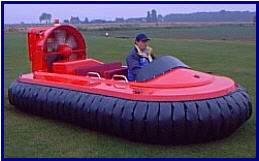What different types of hull are there?
There are a number of methods of hull construction, each with advantages and disadvantages.
AluminiumThe first hovercraft were constructed from aluminium using aircraft methods.
Disadvantages: Tends to be heavy. Expensive.
Advantages: Very strong.
GRPGlass reinforce plastic, or glassfibre, is the most common hull material for professionally built craft.
Disadvantages: Needs a mould, lots of space and some skill. Suited to professional manufacturers. Can be heavy.
Advantages: Complex shapes can be manufactured easily, good strength to weight, robust and repairable, doesn’t corrode.
GRP-Foam compositeA layer of high density PU foam has a lightweight GRP cloth bonded on both sides.
Advantages: Extremely stiff, light and strong material. Suited to home-build or professional build. Provides the best strength to weight of the common construction methods. This is probably the best construction method suited to home construction of medium to large craft (12 feet and upwards).
Disadvantages: Labour intensive process.
WoodThis is the traditional home-build material.
Advantages: Can be a light, cheap and easily constructed material, suited to moderate skill levels.
Disadvantages: Construction quality dependant on the skill of the constructor. Can be heavy if the wrong grades are chosen. Will rot in time.
There a no modern designs for wooden construction, and the potential constructor is best advised to look at GRP-foam composite instead.
Polystyrene foam – Epoxy resinLarge blocks of polystyrene foam are carved into the required shape and covered with glass fibre cloth and epoxy resin. This method can be used for home-built craft given a suitable design.
Advantages: Complex shapes can be made as one-offs. Light and strong.
Disadvantages: Expensive and labour intensive.
ProvenanceWhat does this mean? Essentially, where did the craft come from… there have been many hovercraft manufacturers, ranging from excellent to poor, and in addition many craft have been home-built, again to variable standards.

High quality professional cruising craft or 3 seats or more do not come up for sale very often, and when they do, they command a price starting at 7 to 10 thousands of pounds. By contrast, many ‘Challenger’ style home built craft come up for sale, and whilst they can be had for a few hundred pounds, they are not suitable for cruising use. If you simply want a fun toy to fly around the paddock on, go ahead and have fun! In between are a few small craft which can make a sensible ‘starter’ craft, and will probably cost somewhere between three and eight thousand pounds for a good one.

Occasional larger home-built craft come up for sale, and where built to established plans, such as the well known Universal Hovercraft or SevTec, these can be a very good buy, provided that the build quality is good. As ever, join the club and seek advice before parting with your money.
Back